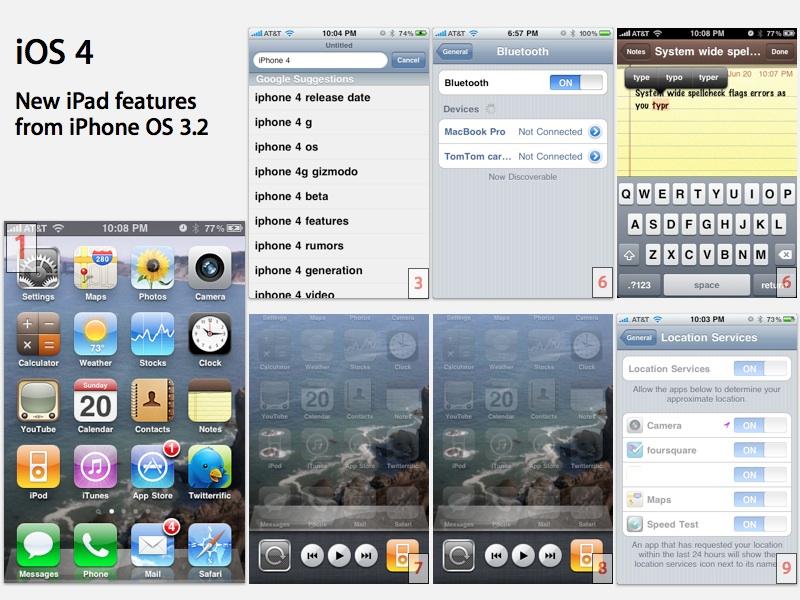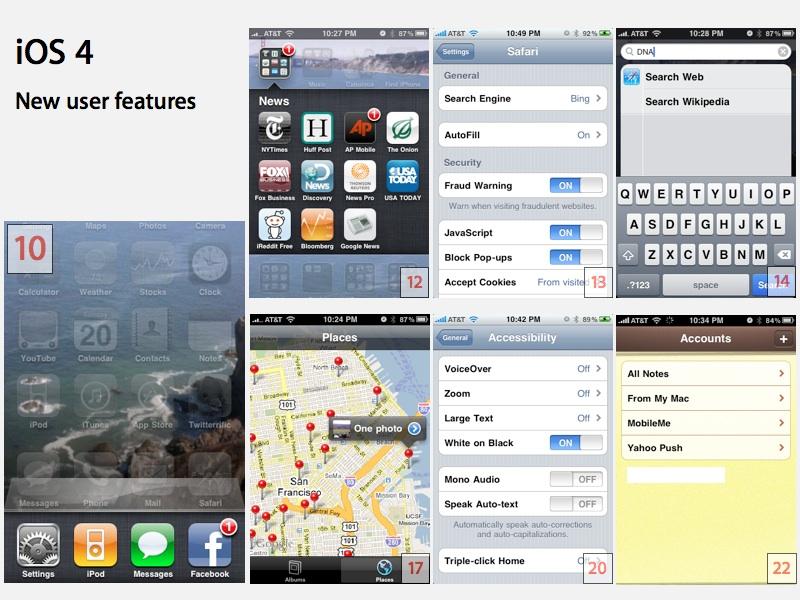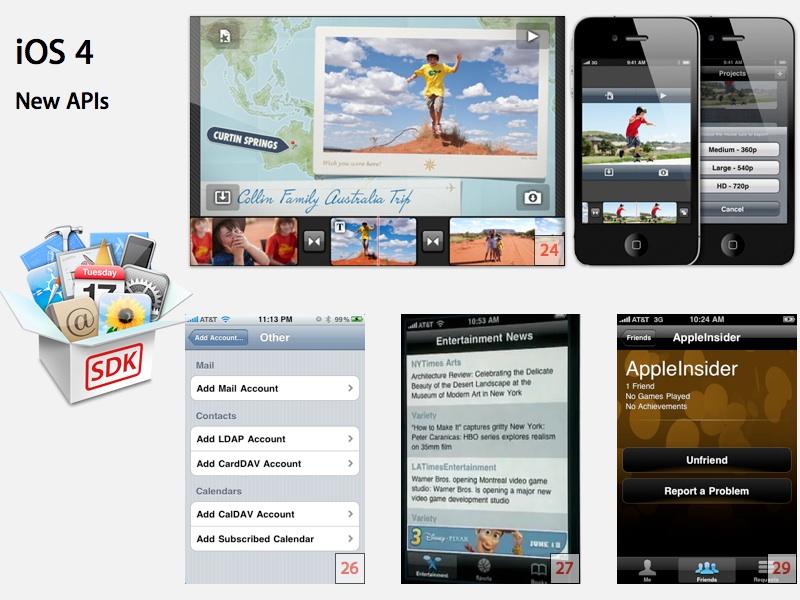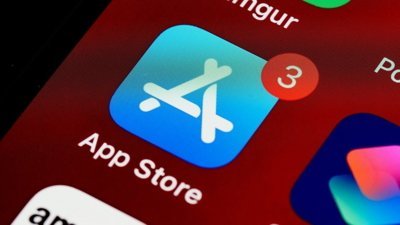First Look: Apple's iOS 4 for iPhone, iPod touch
Apple's iOS 4 provides a variety of new and enhanced features on a core OS level, on a developer API level, and on the surface for end users. Some of these features are limited to new hardware in the latest iPhone 4 (such as FaceTime video calling), while others are only available on last year's iPhone 3GS and third generation iPod touch (including multitasking).
iOS 4 is not supported on the original 2007 iPhone and iPod touch models, and can't be installed on iPad. Apple says a later release this fall will bring iOS 4 features to iPad users, much like the special iPhone OS 3.2 that was exclusive to the iPad at its launch. For all other iOS device users, iOS will be made available for immediate download as a software update within iTunes; that's an distinct advantage Apple holds over most other smartphone platforms, where users might wait months for a new software update to be made available by their mobile provider and for their specific phone model.
iPad features for other mobile devices
iOS 4 delivers a number of features from iPhone OS 3.2 (as it was called upon its release), which debuted on iPad this spring, to iPhone and iPod touch users. These include:
- 1. A revised look and feel reminiscent of the Mac OS X desktop, including a glass shelf Dock, translucent status bar, and support for custom wallpaper on the Home screen. Gone are Apple's efforts to differentiate the iPhone and iPod touch by giving each a different dock design and withholding apps from the touch. The only real differences between the iPhone and iPod touch now relate to hardware, and iOS 4 works to abstract away any differences wherever possible.
- 2. Support for iTunes "File Sharing," which copies documents associated with a specific app on or off the device when it syncs with iTunes. iOS 4 also exposes the concept of opening email attachments with a particular app, another feature that debuted on iPad.
- 3. Support for suggested search terms in Safari when users begin entering a query.
- 4. HTML5 videos can now play within the browser window, rather than launching the QuickTime full screen player, similar to how iPad works.
- 5. Support for Apple's iBooks ebook reader and store app, which now also functions as a PDF document library and viewer.
- 6. Support for Bluetooth keyboards and for system-wide spell check, word suggestion and replacement, and other developer-extendable features that can be included in the text selection copy/paste menu. International layouts on the virtual keyboard can also now be selected from a contextual menu rather than just cycling through multiple configured layouts by hitting the globe icon.
- 7. iPod music playback now gets album art in its listings, and presents additional metadata for the currently playing song or podcast when the user brings up playback controls. Users can also create playlists on the device, rather than only syncing configured playlists from iTunes or only creating simple iPod-style "on the go" playlists.
- 8. A software orientation lock, like the iPad's hardware switch, enables users to keep their iPhone from flipping back and forth between landscape and portrait when holding the device perpendicular to the ground (such as when lying in bed). In iOS 4, the orientation lock is presented when you double-click on the Home button and swipe to the left. Also available in this menu are background audio controls, which default to iPod playback but can also be used by third parties with apps that support Background Audio multitasking (something that isn't yet available on iPad).
- 9. A new Location Services icon in the menu bar that flags when the current app is accessing your location, either using GPS or WiFi triangulation. Apple reports this to the user for privacy reasons, and also forces apps to request permission to perform location lookups via the operating system, so that apps can't track users' location without their being aware that Location Services are active. In iOS 4, there is also now per-app preferences for enabling or disabling specific titles from determining location. Apps that lookup the user's location are flagged on the Location Services page within Settings so users can track which apps are tracking them. iPad does not yet expose this new fine grained control in its Location Services preferences.
On page 2 of 3: New user features in iOS 4.
The new release also ushers in new features that aren't available on iPad and won't be until Apple delivers a custom release for it this fall. These include:
- 10. Multitasking, the biggest feature of the new system. AppleInsider detailed how the new multitasking features work (there are multiple classes of multitasking support) and how it differs from other smartphone platforms that simply allow lots of apps to all be left running in the background. Apps updates are already being posted to iTunes with new support for different levels of multitasking.
- 11. FaceTime, exclusive to the iPhone 4.
- 12. New Folders for organizing groups of up to a dozen apps into a collection. Drag an app on top of another and a Folder is created. Drag in additional apps (but not folders; they don't combine or nestle) and you end up with an icon full of the first nine app's mini icons. This feature packs lots of apps into a small space and keeps them organized, but the app icons are no longer as readily visible, so you might need to start launching apps via Spotlight rather than trying to hunt them down visually. Folders can also be created and managed in iTunes.
- 13. Support for Microsoft Bing in Safari as an alternative search engine to Google (the default) or Yahoo.
- 14. A new ability to use the Spotlight page to launch searches via Safari (via the currently selected search engine) or Wikipedia.
- 15. Search support in Messages for looking up text in SMS messages. The app also gets a message character counter to avoid overshooting the 150 per-message limit.
- 16. Mail now presents multiple accounts in a single unified mailbox view. There's also new threading features for following emails in a conversation, rather than just by date received. Mail also supports multiple Exchange ActiveSync accounts at once. When sending photos as attachments, Mail offers to reduce the message size by scaling down the photos (similar to the desktop Mac OS X Mail).
- 17. Photos adds support landscape browsing of album, and for Events, Faces, and Places from iPhoto, and also tracks GPS geolocation Places tagged by the Camera app.
- 18. Camera gets tap to focus when recording video (on iPhone 3GS or newer phones), a digital zoom feature, and new support for the additional cameras and LED flash
- 19. iOS 4 adds support for stronger lock passwords rather than just a 4-digit PIN.
- 20. New support for accessibility features, including additional braille devices via Bluetooth and audible keyboard feedback.
- 21. YouTube now supports portrait orientation video playback.
- 22. Notes now supports the idea of accounts, allowing users to view local notes (that aren't synced) and additionally notes synced with external accounts, including MobileMe or other IMAP services.
On page 3 of 3: New features for developers.
iOS 4 adds a lot of under the hood plumbing for third party developers to exploit in their apps, along with general core OS features that enable new functionality and make the system faster and more robust. Apple claims 1500 new APIs for developers in iOS 4. Many are rather esoteric, but there's a few that are very visible to users:
- 23. New core OS features that bring iOS into feature parity with Mac OS X Snow Leopard, including support for Blocks and Grand Central Dispatch, IPv6 networks and SSL VPNs.
- 24. New access to camera features, from raw pixel data for still photography applications to full video access and a new AV Foundation framework that provides the core functionality Apple exposed it its own new iMovie app. iOS 4 also adds enhanced new support for HTTP Live Streaming for adaptive live and on-demand streaming of video, and provides rich access to photos and videos via Media Library APIs.
- 25. CoreMotion for sophisticated use of accelerometer and magnetometer (compass) data, along with the new gyroscope in iPhone 4.
- 26. Support for Calendar data store access from the new Calendar Event Kit, enabling apps to create and work with event information. Apple also now supports CalDAV-compliant account sync in Calendar (used by Mac OS X Server's Calendar Server) and CardDAV-compliant account sync in Contacts (used by Address Book Server). Developers can also incorporate SMS features into their apps, add Quick Look support, and use improvements to Map Kit for drawing routes or adding overlays to map views they embed in their apps.
- 27. The new iAd, more than being just a revised new type of mobile ads, is actually deeply integrated into iOS to allow developers to easily add support for subtle advertising within their apps that provides the maximum payback. That means more potential for apps that might not otherwise exist without a sponsor.
- 28. New support for advanced OpenGL ES features, including sophisticated shadows, full scene anti-aliasing for graphics smoothing, and new optimizations for performance.
- 29. The new Game Center is present in iOS 4 as a developer preview, but won't be ready for prime time until later in the year. Developers will need to add support for Game Center to their apps.
- 30. New Accelerate APIs provide hundreds of mathematical functions optimized for iPhone and iPod touch, including signal-processing routines, fast Fourier transforms, basic vector and matrix operations, and industry-standard functions for factoring matrices and solving systems of linear equations.
 Daniel Eran Dilger
Daniel Eran Dilger













 William Gallagher
William Gallagher
 Malcolm Owen
Malcolm Owen
 Sponsored Content
Sponsored Content



 Christine McKee
Christine McKee







